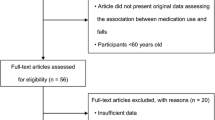Abstract
Background: Antidepressant medications have long been implicated as a cause of falls in older people, but there are few data on the risk of falls associated with exposure to serotonin-norepinephrine (noradrenaline) reuptake inhibitors (SNRIs).
Objective: The aim of this study was to determine the role of SNRIs in older people with a recorded fall in primary care using a case-control approach and a self-controlled case-series analysis of data from The Health Improvement Network (THIN) UK primary care database.
Methods: Cases were 9862 individuals aged >60 years with a first fall recorded between 2003 and 2006. Up to six controls per case were matched by age, sex and primary care practice. For the case-series analysis, we extended our case set to those with a first fall recorded between 2001 and 2008. We estimated odds ratios (ORs) for ‘ever’, ‘current’, ‘recent’, ‘previous’ or ‘never’ prescribed SNRIs (and for the other main classes of antidepressants, for comparison) in cases compared with matched controls, using conditional logistic regression. We also examined the effect of the time interval from first prescription to first fall. In the case-series analysis, we compared the rate of occurrence of first falls during episodes of exposure to SNRIs with unexposed periods in our case group.
Results: There was an increased risk of current prescribing of SNRIs (adjusted OR 1.79; 95% CI 1.42, 2.25) in first fall cases compared with controls. This was similar in magnitude to that seen with tricyclic antidepressants (TCAs) and selective serotonin reuptake inhibitors (SSRIs). The increase in risk was apparent within the first 28 days after first prescription. The effects were also apparent in the self-controlled case-series analysis, although the magnitudes of effect were slightly smaller; the incidence risk ratio for the period 1–28 days after initiation of treatment compared with unexposed periods was 1.49 (95% CI 1.15, 1.93).
Conclusions: Treatment with SNRIs in older people may be associated with an increased risk of falling. The falls risk profile of SNRIs appears to be similar to that of SSRIs and TCAs.




Similar content being viewed by others
References
Leipzig RM, Cumming RG, Tinetti ME. Drugs and falls in older people: a systematic review and meta-analysis. II: cardiac and analgesic drugs. J Am Geriatr Soc 1999 Jan; 47(1): 40–50
Vestergaard P, Rejnmark L, Mosekilde L, et al. Selective serotonin reuptake inhibitors and other antidepressants and risk of fracture. Calcif Tissue Int 2008 Feb; 82(2): 92–101
Kallin K, Gustafson Y, Sandman PO, et al. Drugs and falls in older people in geriatric care settings. Aging Clin Exp Res 2004 Aug; 16(4): 270–6
Whitaker HJ, Farrington CP, Spiessens B, et al. The self-controlled case series method. Stat Med 2006; 25(10): 1768–97
INPS. Vision system. 2011 [online]. Available from URL: http://csdmruk.cegedim.com/our-data/statistics.html [Accessed 2011 Sep 12]
Gribbin J, Hubbard R, Smith C, et al. Incidence and mortality of falls amongst older people in primary care in the United Kingdom. QJM 2009 Jul 1; 102(7): 477–83
British Medical Association, Britain RPSoG. British national formulary. London: BMJ Publishing Group, 2008
Hartikainen S, Lonnroos E, Louhivuori K. Medication as a risk factor for falls: critical systematic review. J Gerontol A Biol Sci Med Sci 2007 Oct; 62(10): 1172–81
Woolcott JC, Richardson KJ, Wiens MO, et al. Meta-analysis of the impact of 9 medication classes on falls in elderly persons. Arch Intern Med 2009 Nov 23; 169(21): 1952–60
Deyo RA, Cherkin DC, Ciol MA. Adapting a clinical comorbidity index for use with ICD-9-CM administrative databases. J Clin Epidemiol 1992 Jun; 45(6): 613–9
Hubbard R, Farrington P, Smith C, et al. Exposure to tricyclic and selective serotonin reuptake inhibitor antidepressants and the risk of hip fracture. Am J Epidemiol 2003 Jul 1; 158(1): 77–84
Thiru K, Hassey A, Sullivan F, et al. Systematic review of scope and quality of electronic patient record data in primary care. BMJ 2003 May 17; 326(7398): 1070–4
Sterke CS, Verhagen AP, van Beeck EF, et al. The influence of drug use on fall incidents among nursing home residents: a systematic review. Int Psychogeriatr 2008 Oct; 20(5): 890–910
Ziere G, Dieleman JP, van der Cammen TJ, et al. Selective serotonin reuptake inhibiting antidepressants are associated with an increased risk of nonvertebral fractures. J Clin Psychopharmacol 2008 Aug; 28(4): 411–7
Richards JB, Papaioannou A, Adachi JD, et al. Effect of selective serotonin reuptake inhibitors on the risk of fracture. Arch Intern Med 2007 Jan 22; 167(2): 188–94
Darowski A, Chambers SA, Chambers DJ, et al. Antidepressants and falls in the elderly. Drugs Aging 2009; 26(5): 381–94
Mottram PG, Wilson K, Strobl J. Antidepressants for depressed elderly. Cochrane Database Syst Rev 2006 Jan 25; (1): CD003491
Mukai Y, Tampi RR, Mukai Y, et al. Treatment of depression in the elderly: a review of the recent literature on the efficacy of single- versus dual-action antidepressants. Clin Ther 2009 May; 31(5): 945–61
Papakostas GI, Thase ME, Fava M, et al. Are antidepressant drugs that combine serotonergic and noradrenergic mechanisms of action more effective than the selective serotonin reuptake inhibitors in treating major depressive disorder? A meta-analysis of studies of newer agents. Biol Psychiatry 2007 Dec 1; 62(11): 1217–27
Sussman N. SNRIs versus SSRIs: mechanisms of action in treating depression and painful physical symptoms. Prim Care Companion J Clin Psychiatry 2003; 5Suppl. 7: 19–26
Acknowledgements
No sources of funding were used to conduct this study or prepare the manuscript. Jonathan Gribbin received a grant from East Midlands Strategic Health Authority to cover student fees. The authors have no conflicts of interest that are directly relevant to the content of this study.
Author information
Authors and Affiliations
Corresponding author
Rights and permissions
About this article
Cite this article
Gribbin, J., Hubbard, R., Gladman, J. et al. Serotonin-Norepinephrine Reuptake Inhibitor Antidepressants and the Risk of Falls in Older People. Drugs Aging 28, 895–902 (2011). https://doi.org/10.2165/11592860-000000000-00000
Published:
Issue Date:
DOI: https://doi.org/10.2165/11592860-000000000-00000




